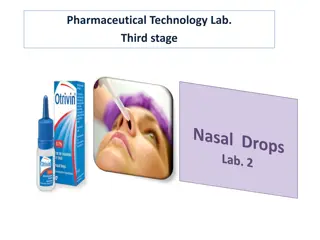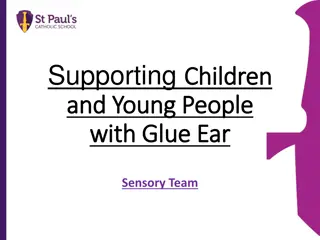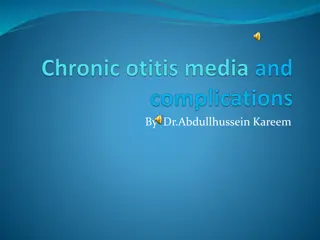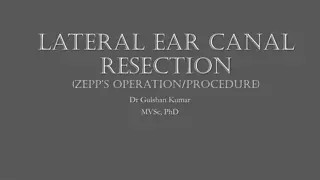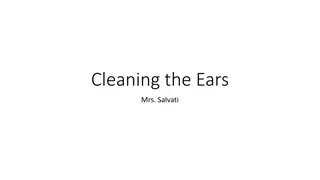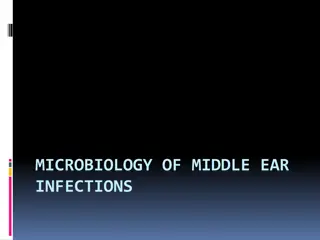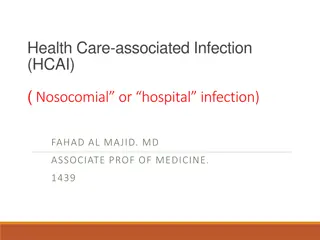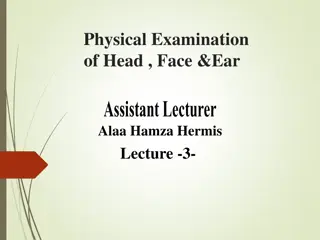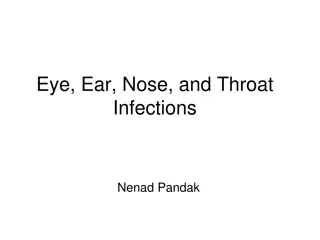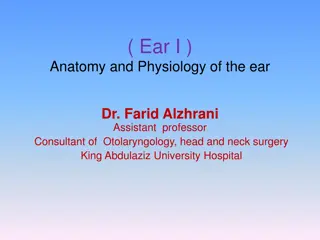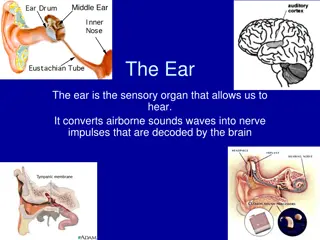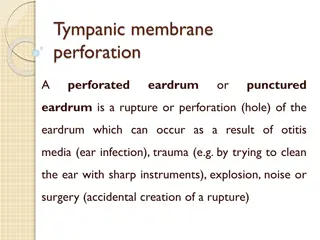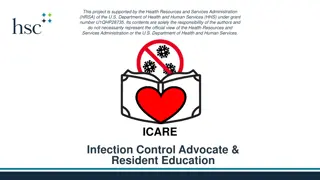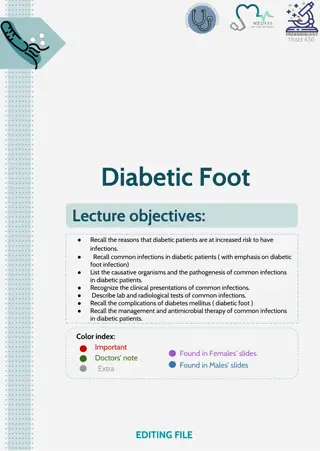Pharmaceutical Technology Lab: Nasal and Ear Drops Formulations
Learn about the formulation and use of nasal and ear drops in pharmaceutical technology labs. Explore details on nasal drops for nasal passages, ephedrine nasal drop recipe, notes on ingredients, ear drops for ear care, sodium bicarbonate ear drop recipe, and procedures for preparation. Understand t
2 views • 13 slides
Understanding Anaemia and Infections in Relation to Health
Anaemia can result from various causes such as blood loss, increased destruction of red blood cells, and impaired production, often linked to infections and chronic diseases. Parasites, bacteria, and viruses play a role in the progression of anaemia, affecting the body's ability to produce and utili
3 views • 10 slides
Understanding Nontuberculous Mycobacteria Infections in Cystic Fibrosis
Nontuberculous mycobacteria (NTM) infections present a significant challenge in individuals with cystic fibrosis (CF). These infections are caused by over 200 species of atypical mycobacteria found in various environments. The CF-ID Clinic plays a crucial role in managing patients with multi-drug re
2 views • 25 slides
Understanding Frequency Weighting in Noise Pollution Measurement
Frequency weighting is essential in noise pollution measurement to reflect how the human ear perceives noise. The A, C, and Z weightings are commonly used to represent different frequency responses. A-weighting covers the audible frequencies where the human ear is most sensitive, while C-weighting i
3 views • 7 slides
Anaerobic Bacterial Infections: Overview and Clinical Implications
Anaerobic bacterial infections are caused by bacteria that do not require oxygen for growth, posing challenges in diagnosis and treatment. This article delves into the types of anaerobic bacteria, their role in human infections, and common clinical presentations such as abscess formation. Gram-negat
2 views • 24 slides
Understanding Glue Ear in Children and Young People
Glue ear is a condition where the middle ear fills up with fluid, causing temporary hearing loss. It is important to be aware of the signs of glue ear, such as speaking loudly, asking for repetition, and finding it hard to concentrate. The impact of glue ear can affect physical comfort, balance, spe
0 views • 15 slides
Ear Cropping: Overview, Procedure, and Legal Status in Veterinary Practice
Ear cropping is the surgical procedure of removing part or all of a dog's pinnae or ear flap. While banned in many countries, it remains legal in specific breeds for certain purposes. This detailed guide covers the introduction, indications, age requirements, surgical process, post-operative care, a
0 views • 14 slides
Anatomy of the Pharyngo-Tympanic Tube (Eustachian Tube) Explained
The pharyngo-tympanic tube, also known as the Eustachian tube or auditory tube, is a vital structure connecting the nasopharynx with the tympanic cavity. It plays a crucial role in maintaining air pressure equilibrium on both sides of the tympanic membrane. Comprising bony and cartilaginous parts, i
0 views • 14 slides
Understanding Fungi Diversity and Infections in Microbiology
Explore the world of fungi and fungal infections in this foundation block of microbiology. Learn about medically important yeasts, mold fungi, major fungal diseases, antifungal agents, and infection acquisition methods. Dive into hypersensitivity reactions, mycotoxicoses, and various types of fungal
1 views • 19 slides
Otitis Externa: Overview, Risk Factors, and Treatment
Otitis externa, also known as swimmer's ear, is an inflammation of the external auditory canal. It can be acute or chronic and is common among individuals aged 7-14 years. The main causative organisms include Pseudomonas aeruginosa and Staphylococcus aureus. Risk factors include swimming in pools, h
0 views • 10 slides
Chronic Otitis Media: Classification, Causes, and Management
Chronic otitis media is a persistent inflammation of the middle ear mucosa and mastoid process for more than 3 months. It can be classified as tubotympanic or attico-antral, with the new classification including inactive and active mucosal and squamous types. The condition is influenced by factors l
0 views • 36 slides
Understanding Virus-Cell Interactions and Infections
Viral infections exhibit diverse cellular tropism based on receptor interactions, impacting cell function through modulation and potential host defense responses. Infections can lead to various outcomes, from cell death to persistent or latent states, with nuanced effects on cellular behavior. Diffe
0 views • 8 slides
Understanding Antiamebic Drugs: A Guide to Managing Protozoal Infections
Protozoal infections, such as amebiasis, are a significant concern globally. In underdeveloped regions and beyond, these infections pose challenges due to inadequate sanitation and hygiene practices. Antiamebic drugs are essential for treating conditions like amebiasis, caused by Entamoeba histolyti
0 views • 40 slides
Understanding Anthelmintics: Drug Therapy for Parasitic Worm Infections in Veterinary Medicine
Anthelmintics are essential drugs to combat parasitic worm infections in animals. They work either by killing (vermicide) or expelling (vermifuge) the worms, reducing worm burdens and controlling infections. This comprehensive overview covers different aspects of anthelmintics, including their prope
2 views • 34 slides
Understanding the Treatment of Respiratory Tract Infections: Antibiotics and Management
This lecture covers the classification of respiratory tract infections and the antibiotics commonly used to treat them. It highlights the types of infections caused by viruses and bacteria, along with their respective treatments. The mechanism of action and pharmacokinetics of antibiotics, such as p
0 views • 7 slides
Management of Symptomatic Ear Wax in Adults: Olive Oil Drops vs. Alternative Solvents
Adults (>18 yrs) presenting with symptomatic ear wax often seek interventions like olive oil drops or alternative ear wax solvents. A study compared the efficacy of olive oil drops in conjunction with syringing versus alternative treatments or no treatment. PubMed search yielded 26 papers, with 2 re
5 views • 12 slides
Understanding the Transition to Middle School: Key Insights for Parents
Navigating the transition to middle school can be a significant milestone for both parents and students. This comprehensive guide offers valuable information on the unique developmental needs of early adolescents, the differences encountered in middle school such as homework and grading systems, and
0 views • 20 slides
Lateral Ear Canal Resection (Zepp's Operation) by Dr. Gulshan Kumar
Lateral ear canal resection, also known as Zepp's operation, is a surgical procedure performed by Dr. Gulshan Kumar, MVSc, PhD. This operation involves the removal of a portion of the lateral ear canal to treat various ear conditions. The images show different stages of the procedure, providing a vi
0 views • 6 slides
Guide to Safe and Effective Ear Cleaning for Pets
Learn how to safely clean your pet's ears with step-by-step instructions, images, and tips. Discover the anatomy of the ear, identify ear problems, and understand the materials needed. Follow safety precautions and ensure your pet's comfort during the cleaning process.
0 views • 8 slides
Understanding How the Ear Works and Common Issues
The ear functions for hearing and balance, with the cochlea for hearing and semicircular canals for balance. Sound waves are funneled through the pinna, vibrate the eardrum, pass through the ossicles, and move fluid in the inner ear to transmit nerve impulses. Important terms include auditory cortex
0 views • 19 slides
Overview of Middle Ear Infections: Microbiology, Classification, and Risk Factors
Middle ear infections, known as otitis media (OM), are common, especially in infants. The microbiology, anatomy, classification, epidemiology, pathogenesis, and risk factors of middle ear infections are discussed in detail. Factors like URTI, allergies, and exposure to pathogens contribute to the de
0 views • 22 slides
Ear-Related Ages: Exploring the Connection Between Age and Ear Health
Exploring the ages of 4, 14, 24, 34, 54, 74, and 84 years old in relation to ear health with references to research articles from J. Vestib. Res. This collection examines the impact of age on ear-related conditions and provides insight into maintaining ear health across different stages of life.
0 views • 28 slides
Understanding Health Care-associated Infections (HCAI) in Hospital Settings
Health care-associated infections (HCAI), also known as nosocomial or hospital infections, are infections that occur in patients during their hospital stay or after discharge. These infections can result from various sources, including colonization by microorganisms and exposure to contaminated envi
0 views • 48 slides
Comprehensive Physical Examination of Head, Face, and Ear
This content provides detailed guidance on conducting a thorough physical examination of the head, face, and ear. It covers objectives such as safely completing the examination, documenting assessment data accurately, and evaluating findings. The preparation, general approach, and specific inspectio
0 views • 21 slides
Overview of Eye, Ear, Nose, and Throat Infections by Nenad Pandak
In this comprehensive guide by Nenad Pandak, various aspects of eye, ear, nose, and throat infections are discussed. The content covers infections such as conjunctivitis, keratitis, pharyngitis, otitis media, and sinusitis. It also delves into causes, clinical presentations, and diagnosis of these i
0 views • 68 slides
An In-depth Look at the Anatomy and Physiology of the Ear by Dr. Farid Alzhrani
Delve into the comprehensive insights provided by Dr. Farid Alzhrani, Assistant Professor and Consultant of Otolaryngology, Head, and Neck Surgery at King Abdulaziz University Hospital, on the intricate details of the ear's anatomy and physiology. Explore topics such as the external ear structures,
0 views • 41 slides
Understanding Respiratory Tract Infections: Causes and Prevention
Respiratory tract infections are commonly caused by viruses, bacteria, rickettsia, and fungi, leading to various health issues. These infections can be transmitted through droplets, droplet nuclei, and dust, emphasizing the importance of maintaining respiratory health through specific and non-specif
0 views • 34 slides
Understanding Middle School Transition: Insights for Parents of Rising Sixth Graders
Explore key insights for parents of rising sixth graders regarding the middle school transition, including information on school administrators, vision and beliefs, differences in middle school, traits of middle school students, and the unique concept of middle school as a bridge between elementary
0 views • 20 slides
Understanding How the Ear Works - A 6th Grade Science Guide
The ear is a complex organ divided into three main parts: the outer ear, middle ear, and inner ear. Each part plays a crucial role in the process of hearing. Vibrations travel through the outer ear canal, vibrate the eardrum, and pass through the tiny bones of the middle ear to reach the cochlea. Ha
0 views • 8 slides
Exploring the Physics of Hearing and the Incredible Mechanics of the Ear
Discover the fascinating world of hearing and speech communication, delving into the intricate workings of the human ear. From the importance of speech and hearing for human interaction to the inner mechanisms of the ear's ability to convert sound waves into electrical signals for the brain, this ex
0 views • 29 slides
Understanding the Anatomy of the Ear
The ear is a complex sensory organ that enables us to hear by converting sound waves into nerve impulses processed by the brain. It consists of the outer, middle, and inner ear, each playing a crucial role in the hearing process. Changes in air pressure can affect the ear, causing discomfort that ca
0 views • 17 slides
Understanding Tympanic Membrane Perforation: Causes, Symptoms, and Management
A tympanic membrane perforation, or perforated eardrum, can result from various factors such as infections, trauma, loud noises, or surgery. It presents with symptoms like pain, hearing changes, and ear fullness. Different types of perforations exist, and diagnostic procedures include history collec
0 views • 18 slides
Understanding the Human Ear: Structure, Function, and Adaptations
Explore the intricate structure of the human ear, its role in hearing, and adaptations for sound absorption. Learn about the functions of different ear parts, from the pinna to the auditory nerve, in converting sound waves into nerve impulses for interpretation by the brain.
0 views • 14 slides
Understanding Ear Tumors and Cholesteatoma: Causes, Symptoms, and Management
Ear tumors such as Glomus tumor and Acoustic neuroma can affect vital functions of the ear, leading to symptoms like tinnitus, vertigo, hearing loss, and facial nerve disorders. Surgical excision is a common treatment method. Cholesteatoma, an abnormal skin growth in the middle ear, can also cause c
0 views • 13 slides
Understanding Viral Infections of the Respiratory System
Respiratory viral infections are common and primarily caused by viruses, leading to morbidity and time off work. They can range from mild upper respiratory tract infections to severe lower respiratory tract infections like pneumonia. Various viruses like influenza, parainfluenza, respiratory syncyti
0 views • 23 slides
Understanding Ear Wax (Cerumen) and Its Management
Ear wax, also known as cerumen, is a yellowish waxy substance secreted in the ear canal to protect, clean, and lubricate. Excess ear wax can lead to hearing issues, such as partial loss or malfunction of hearing aids. Learn about the types of ear wax, symptoms of blockage, and safe methods of remova
0 views • 9 slides
Understanding Common Infections in Nursing Home Residents
Explore the causes, types, and impact of infections in nursing home residents while learning how to prevent and control infections. Discover common infections, factors contributing to infections, and resident rights in infection control practices.
0 views • 23 slides
Understanding Diabetic Foot Infections and Associated Risks
Diabetic patients are prone to infections, significantly impacting morbidity and mortality rates. Increased infection risk is due to both host-related and organism-related factors. Common infections in diabetic patients include skin and soft tissue infections, diabetic foot infections, respiratory t
0 views • 14 slides
Preventing Catheter-Associated Urinary Tract Infections
This presentation covers the prevention of catheter-associated urinary tract infections (CAUTIs) in healthcare settings. It highlights the significance of urinary tract infections, risk factors, preventive measures, and common microbiology involved. Key topics include the importance of urine collect
0 views • 34 slides
Managing Catheter-Related Bloodstream Infections in Vascular Access
Reduce and prevent catheter-related bloodstream infections in vascular access by addressing extraluminal infection sources and implementing strategies outlined in national drivers such as the NHS Long Term Plan and the Antimicrobial Resistance Action Plan. Recognize the importance of tackling antimi
0 views • 25 slides
